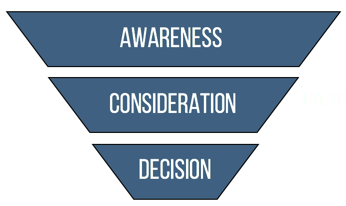By this point, we’ve all become aware that the fundamental way that people make buying decisions has changed. We know that the internet is leveraged heavily, and people are leveraging tools such as review apps (i.e. Yelp) to help make informed decisions. They are not only communicating with one another online, they are also communicating directly with companies online through social media.
We hear it all the time, but what we don’t hear is how a company needs to break down the buying process into multiple steps, and in a major way, communicate differently to prospects based off of where they are in the buying journey.
The Internet Changed Everything

This use to be a very linear model, where someone needed something, and they simply went to somewhere that sold their product and bought what was recommended to them (i.e. auto repair store). This decision process now is very fluid and starts with a simple Google search.
The fact that the decision now starts with the consumer doing research on their own has changed absolutely everything. No longer does a sales person have the ability to influence their immediate decision, and more so, they do not have the capacity to persuade them into thinking they need something that they really might not. What has resulted due to this change is a modified buyer’s decision journey.
Marketers must understand this model well, and speak to consumers differently at each stage of their journey. Trying to sell a prospect on why your organization makes sense will simply be white noise and likely will come off as annoying. However, offering up valuable information about an issue they may have is perfect during this phase, and will probably help engage you with them from the very beginning.
The New Buyers Journey

It’s easiest to visualize the new buyers journey in a funnel format. From a quick glance, someone becomes aware they have a need or problem; they consider what their options are, and then they make a decision. While this seems simple from a buyer’s standpoint, as businesses we need to be extremely detail-oriented as to how we interact with prospects through this journey. Let’s break each stage down one by one:
Awareness

During the awareness stage, someone becomes “aware” they may need something. This could be due to many things. For example, an IT director could become aware a networking switch has gone bad and they need to find a replacement. Another example is someone becomes aware they need a larger car since they may be having a child.
During the awareness stage, people are only researching their issue and trying to find out what the solution should be. They are looking for content (i.e. an eBook) that can help educate them on their problem. Anything that is vendor/company specific is going to be ignored, as it will be viewed as sales collateral. The last thing a prospect wants to do at this point is hear a company’s sales pitch.
What to do here: Offer value! Have content readily available that isn’t a sales pitch for your business. If you’re a plumber, write a blog on how to stop a leak. The key is to position yourself as a thought leader in this space, while offering up value to someone who has a need that your company solves.
Consideration

A prospect moves into the consideration stage when they have realized they have a problem and identified what that said problem is. Individuals are “considering” what all of their options are at this point. This can be various types of treatment, different types of vehicles that address their need, or anything else that involves evaluating multiple options for a single problem.
What to do here: Again…offer value. The difference here is that it is critical to position yourself as a thought leader in this space. This could be done through a video that showcases how your company addresses this problem or need. Another way could be through an expert guide that walks through in detail how to address an issue.
Decision

When a prospect is in the decision stage, they are committed to solving their problem or need. They know what their options are at this point, and they are doing the research to find validation in the decision they want to make. Individuals could be reading online reviews, comparing pricing, or speaking to other clients. For SaaS-based solution providers, their prospects may be using a trial version of their software to make sure it meets their needs.
What to do here: This is your time to boast about your solution. It’s imperative to have content created for sales that states why your solutions address their need, and why they should purchase this over a competitor’s. It could be straight forward such as price, or it could be value based and explains how this could address a future need they may have down the road. Either way, it should be extremely clear and concise.
Right place, Right Time

While the actual decision process itself hasn’t changed all that much (have a need, identify options, make a decision), the way people do research and make their decision has. People don’t want to be sold to, and they want to make their own decision.
As marketers, we must have a solid inbound strategy that has content available for prospects at each step in the buyer’s journey. Timing is everything here. If you give them content that talks about why your company is the right fit during the awareness stage, then you’re going to push them away. It’s critical to look at your conversion path to make sure the right material get’s in front of them at the right time.
Need help making sure your content matches up with the right decision stage? Leverage our marketing playbook for IT channel partners to make sure you’ve got every step covered: